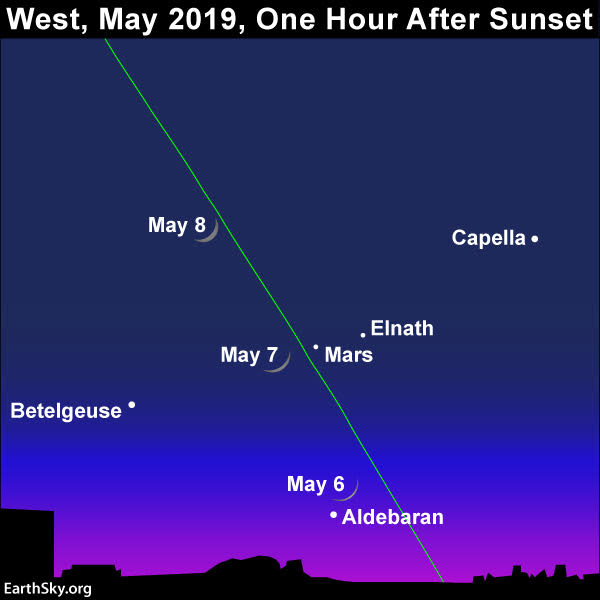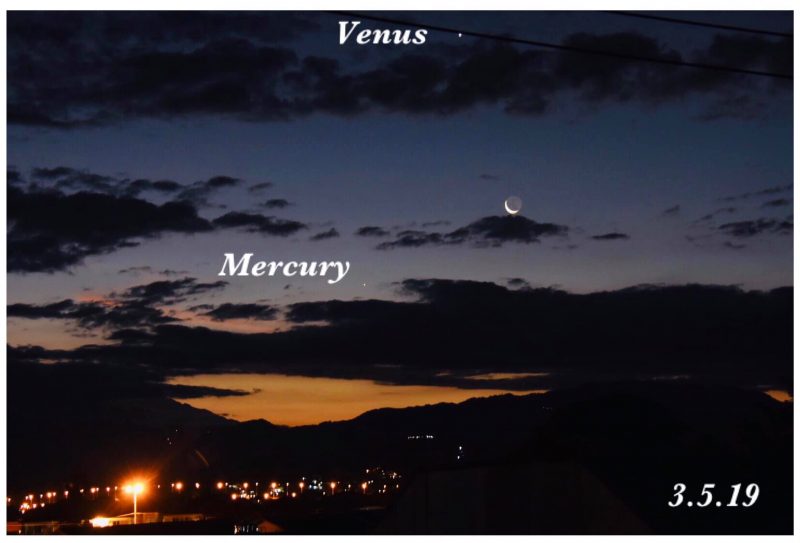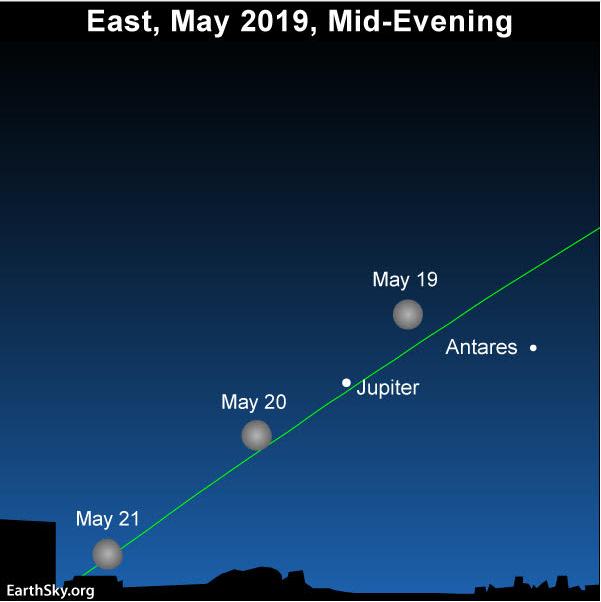May guide to the bright planets
Posted by Bruce McClure and Deborah Byrd in Astronomy Essentials | April 30, 2019Mars pops out at nightfall. Jupiter comes up later, and Saturn later still. Venus sits low in the east at dawn. Southern Hemisphere skywatchers might catch Mercury in early May, but it’s lost in the sunrise from middle and far northern latitudes.
Click the name of a planet to learn more about its visibility in May 2019: Venus, Jupiter, Saturn, Mars and Mercury.

Coming soon! Use the young crescent moon to locate the star Aldebaran and the planet Mars in your western sky as darkness falls. Read more.
Venus is the brightest planet, beaming in the east before sunrise all month long. Watch for the waning crescent moon to join up with Venus in the morning sky for a few days, centered on or near May 1 – and then again on June 1 (see June chart below).
From northerly latitudes, Venus sits low in the glare of morning twilight. The northern tropics and Southern Hemisphere enjoy a much better view of Venus. For all of us, Venus starts out the month at an elongation of 28 degrees west of the sun. It ends the month at 20 degrees west of the sun. Despite Venus being the same angular distance from the sun worldwide, Venus spends more time in the predawn sky at more southerly latitudes. That’s because the ecliptic – or path of the sun, moon and planets – appears more nearly vertical with respect to the sunrise horizon from southerly latitudes at this time of year.
In May, at mid-northern latitudes, Venus rises well after the beginning of astronomical twilight (dawn’s first light). At temperate latitudes in the Southern Hemisphere, Venus comes up before the advent of astronomical twilight all through May 2019.
At mid-northern latitudes, Venus rises about one hour before sunrise throughout the month.
At temperate latitudes in the Southern Hemisphere, Venus rises about two hours before sunup in early May. By the month’s end that’ll decrease to about 1 1/2 hours.
Let the waning crescent moon serve as your guide to the planet Venus, centered on or near May 1 – and then again, on or near June 1. See the sky chart for late May/early June below.

The waning crescent moon pairs up with the queen planet Venus on or near June 1. Read more.
Mercury, the innermost planet of the solar system, passes out of the morning sky and into the evening sky in May 2019. From the northern tropics and the Southern Hemisphere, Mercury might be visible for the first week or so of May. Northerly latitudes will have a tough time catching Mercury, even with binoculars.
On the other hand, in June 2019, Mercury will become a fine evening object from both the Northern and Southern Hemispheres.
If you live in the northern tropics or the Southern Hemisphere, watch for the moon to pair up with Mercury on or near May 3. Jenney Disimon of Sabah, North Borneo, caught the old waning crescent moon with the planets Mercury and Venus before sunrise May 3, 2019, as shown below.

View larger. Jenney Disimon of Sabah, North Borneo, causht the old waning crescent moon with the planets Mercury and Venus before sunrise May 3, 2019. Thank you Jenney!
Jupiter is the second-brightest planet after Venus, and this planet is now rising earlier in our sky, coming into view at late evening in early May, and by dusk/early evening in late May. Jupiter is now approaching its opposition to the sun – marking the middle of the best time of year to see it – and so you’ll want to view Jupiter in the coming weeks. Opposition itself comes on June 10, 2019. Around that time, Jupiter will shine at its brilliant best for the year. Click here for a recommended sky almanac telling you when Jupiter rises into your sky.
That bright ruddy star rather close to Jupiter is Antares, the brightest star in the constellation Scorpius the Scorpion. Although Jupiter shines in the vicinity of Antares throughout 2019, Jupiter can be seen to wander relative to this “fixed” star of the zodiac. This year, in the first three months of 2019, Jupiter was traveling eastward, away from Antares. But starting on April 10, 2019, Jupiter reversed course, moving toward Antares. For the following four months (April 10 to August 11, 2019), Jupiter will be traveling in retrograde (or westward), closing the gap between itself and the star Antares. Midway through this retrograde, Jupiter will reach opposition.
In early May from mid-northern latitudes, Jupiter rises at late evening, roughly 11 p.m. daylight saving time. By the month’s end, Jupiter rises around nightfall.
At the beginning of the month at temperate latitudes in the Southern Hemisphere, Jupiter comes up by mid-evening, around 8 to 9 p.m. By the month’s end, Jupiter rises around nightfall.
Jupiter comes up first in the nightly procession of three bright planets. Saturn follows Jupiter into the sky about two hours after Jupiter first appears, and then Venus makes its appearance low in the eastern sky at dawn.
Watch for the waning gibbous moon to swing by Jupiter on the evenings of May 19 and 20, as displayed on the sky chart below.

Look for the moon near the king planet Jupiter on May 19 and 20. Read more.
Saturn comes up up a few hours after Jupiter. Throughout May, Saturn and Jupiter rise earlier each day, both of them making their appearance about two hours earlier by the month’s end. Saturn, although as bright as a 1st-magnitude star, pales in contrast to Jupiter. Jupiter outshines Saturn by some 14 times.
From mid-northern latitudes, Saturn comes up around the midnight hour (1 a.m. daylight saving time) in early May. By the month’s end, Saturn rises by around 11 p.m. daylight saving time.
From temperate latitudes in the Southern Hemisphere, Saturn comes up around two hours before the midnight hour in early May. As a reminder, midnight in our usage means midway between sunset and sunrise. By the month’s end, Saturn will rise at or around 8 p.m.
Watch for the waning moon to be in the neighborhood of Saturn for several days, centered around May 22 or 23, as shown on the sky chart below.

Unless you’re a night owl, you might want to view the moon and Saturn in the predawn/dawn sky. Read more.
Mars is the only bright planet to come out at nightfall all month long. “Bright” might be an overstatement, as Mars has faded into 2nd-magnitude brightness. Even so, Mars stays out until after nightfall. Given a dark sky, you should be able to spot this world in your western sky at early evening.
Click here for recommended sky almanacs providing you with the setting times for Mars for your location.
Watch for the young crescent moon to shine in the vicinity of Mars for several evenings, centered on or near May 7. The moon’s proximity might provide you with your best opportunity to catch Mars in the evening sky for the rest of 2019. Day by day, this planet is slowly but surely fading, and sinking closer to the afterglow of sunset.

Use the young crescent moon to locate the star Aldebaran and the planet Mars in your western sky as darkness falls. Read more.
What do we mean by bright planet? By bright planet, we mean any solar system planet that is easily visible without an optical aid and that has been watched by our ancestors since time immemorial. In their outward order from the sun, the five bright planets are Mercury, Venus, Mars, Jupiter and Saturn. These planets actually do appear bright in our sky. They are typically as bright as – or brighter than – the brightest stars. Plus, these relatively nearby worlds tend to shine with a steadier light than the distant, twinkling stars. You can spot them, and come to know them as faithful friends, if you try.

Skywatcher, by Predrag Agatonovic.
Bottom line: In May, Mars is the only bright planet to pop out at nightfall all month long. Jupiter rises in the east at mid-to-late evening, whereas Saturn follows Jupiter into the sky about two hours after Jupiter does. Venus sits low in the glare of morning twilight all month long. Mercury is pretty much unobservable from northerly latitudes. Click here for recommended almanacs; they can help you know when the planets rise and set in your sky.
Thanks to: https://earthsky.org






 Sat Mar 23, 2024 11:33 pm by globalturbo
Sat Mar 23, 2024 11:33 pm by globalturbo

